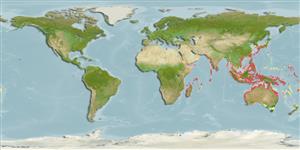Common names from other countries
Classification / Names / Names
Namen | Synonyme | Catalog of Fishes (gen., sp.) | ITIS | CoL | WoRMS
Environment: milieu / climate zone / depth range / distribution range
Ökologie
Riff-verbunden; tiefenbereich 0 - 20 m (Ref. 349). Tropical
Indo-West Pacific: from East Africa to Melanesia; north to Japan and south to northern New South Wales.
Length at first maturity / Size / Gewicht / Alter
Maturity: Lm ? range ? - ? cm Max length : 14.0 cm SHL Männchen/unbestimmt; (Ref. 349); common length : 12.0 cm SHL Männchen/unbestimmt; (Ref. 349)
Mainly collected for its elegant shell (Ref. 349). Found offshore, near coral reefs; associated with soft corals (Ref. 799), particularly on large sea whips (Ref. 349).
Life cycle and mating behavior
Geschlechtsreife | Fortpflanzung | Ablaichen | Eier | Fecundity | Larven
Members of the order Neotaenioglossa are mostly gonochoric and broadcast spawners. Life cycle: Embryos develop into planktonic trocophore larvae and later into juvenile veligers before becoming fully grown adults.
Poutiers, J.M. 1998. (Ref. 349)
IUCN Rote Liste Status (Ref. 130435)
CITES Status (Ref. 108899)
Not Evaluated
Not Evaluated
Nutzung durch Menschen
| FishSource |
Tools
Mehr Information
Alter/Größe
Wachstum
Länge-Gewicht
Länge-Länge
Morphologie
Larven
Dichte
Internet Quellen
Estimates based on models
Preferred temperature
(Ref.
115969): 23.8 - 29.3, mean 28.4 (based on 3165 cells).
Verwundbarkeit
Low vulnerability (10 of 100).
Preiskategorie
Unknown.
